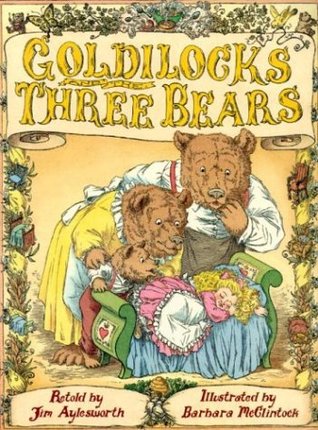
“The Three Bears” by Robert Southey
I always knew this story as “Goldilocks and the Three Bears,” but apparently in its earliest versions the bears’ intruder is actually an old women. Southey’s version is from 1837.
The story itself is familiar. A family of good-natured, trusting bears lives in a nice house in the woods. Each bear has his own chair, bowl of porridge and bed. One day when the three go for a walk in the woods while waiting for their porridge to cool, an ill-tempered, perhaps homeless, old woman enters their home, making sure no one is around to see her. She eats the little bear’s porridge, breaks his chair and eventually falls asleep in his bed. That is where the bears discover her. The small bear cries out that someone has been sleeping in his bed and states she’s still there. The old woman awakens and jumps out the window.
Out the little old Woman jumped; and whether she broke her neck in the fall, or ran into the wood and was lost there, or found her way out of the wood and was taken up by the constable and sent to the House of Correction for a vagrant as she was, I can not tell. But the Three Bears never saw any thing more of her.
Another old version, written by Eleanor Mure in 1831, tells of the bears trying to burn the old woman after they catch her. When that doesn’t work, they try to drown her. When that too is unsuccessful, they “chuck her aloft on St. Paul’s church-yard steeple.” They are bears after all, and she did have no right to be in their house.
Apparently the old woman character was replaced by a young girl in Joseph Cundall’s Treasury of Pleasure Books for Young Children in 1849, but wasn’t christened Goldilocks until 1904 in Old Nursery Stories and Rhymes.
I love seeing how the stories change over time. Goldilocks, like the old woman, is not a pleasant girl, breaking into the house, stealing the bear’s breakfast, making herself at home. I have seen few versions where she’s truly innocent. How do you truly walk into someone’s house when they’re not home without realizing you shouldn’t be doing it?
 In a version I read recently, Goldilocks And The Three Bears retold by Jim Aylesworth, illustrated by Barbara McClintock, the lesson Goldilocks learns is to remember what her mother tells her, especially what her mother tells her not to do, like not to go into the woods, not to use other people’s things without permission, and not to be nosy about other people’s private business. Good lessons for kids to learn, adults to for that matter. The old woman in the original story certainly learned to leave others’ things alone. Of course, at least in one version, she never got the chance to mend her ways. Goldilocks still has hope of turning into a good kid. In the versions she figures in, she always manages to flee from the bears, with no threat of prison. She is after all a little girl.
In a version I read recently, Goldilocks And The Three Bears retold by Jim Aylesworth, illustrated by Barbara McClintock, the lesson Goldilocks learns is to remember what her mother tells her, especially what her mother tells her not to do, like not to go into the woods, not to use other people’s things without permission, and not to be nosy about other people’s private business. Good lessons for kids to learn, adults to for that matter. The old woman in the original story certainly learned to leave others’ things alone. Of course, at least in one version, she never got the chance to mend her ways. Goldilocks still has hope of turning into a good kid. In the versions she figures in, she always manages to flee from the bears, with no threat of prison. She is after all a little girl.
Tif, from Tif Talks Books, is the hostess of this great feature, Fairy Tale Fridays. Head over there to see her take on “The Three Bears” and to share your own thoughts. Next week, we’ll be looking at “The Three Billy Goats Gruff.”
Goldilocks and the Three Bears retold by Jim Aylesworth published September 1, 2003
Suggested Reading Level: Pre-school through Grade 2
32 pages
Challenges: 100+
I borrowed my copy from the library and the above is my honest opinion. I am an Amazon associate.
New style I see, cool 🙂
Ack, Goldilocks, never did like her. And didn’t knwo it used to be an old woman
I love the new design Carol!!!
We are on the same page most of the time!! I guess it’s true that great minds think alike!! 🙂 I have not read the version by Mure. I need to find myself a copy of that one!!